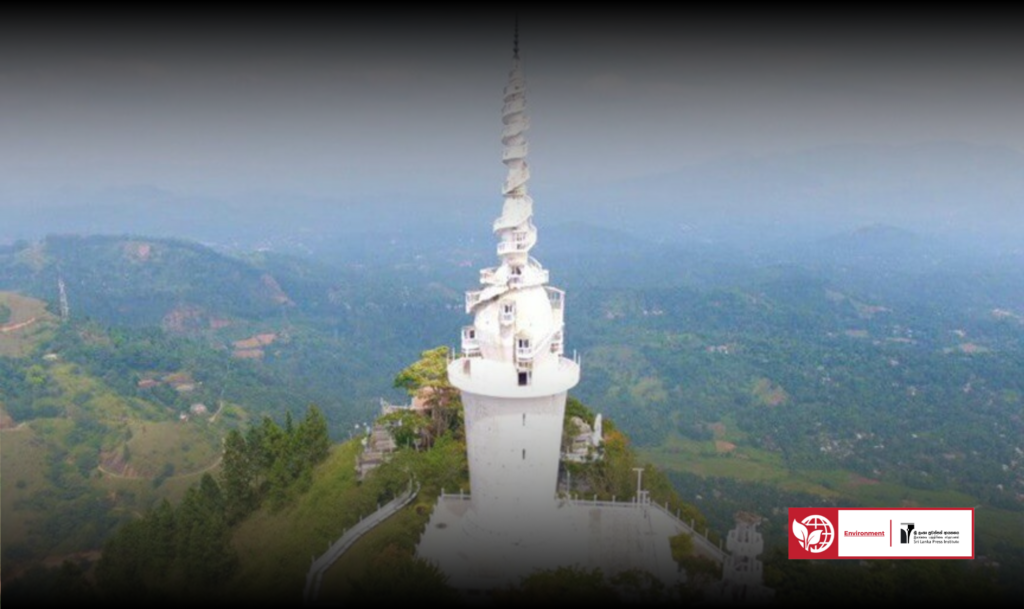Ambuluwawa: A Tower of Harmony as Tall as the Heights of Unity
by Sudeepa Lakshan

The Ambuluwawa Tower majestically rises near Gampola in the western slopes of the Central Province. Attracting both local and international tourists, this iconic structure offers more than just panoramic views. It serves as a symbol of social and environmental service, representing the balance between nature and humanity. Known as the Ambuluwawa Religious Center and Biodiversity Complex, it stands at an elevation of 3,567 feet above sea level, with the tower itself reaching 2,017 feet from the town of Gampola.
The name “Ambuluwawa” derives from the words “Abu-Ulu-Vawa-Gala”, which translates to “the rock where water springs emerge,” symbolizing its rich natural heritage. Spread across 400 acres, Ambuluwawa holds a deep cultural and historical significance, even though early sources are scarce. The only recorded reference to this location comes from the Mayura Sandesaya, a 14th-century poetic work written during the Gampola period, which mentions traveling through “Ambuluwakada.”
Legend has it that during the reign of King Bhuvanaikabahu IV, an ancient herbal garden thrived in the area, a belief supported by the discovery of a wide variety of medicinal plants still found in the region.
Ambuluwawa is not only a marvel of biodiversity but also a place where people of all faiths come together, symbolizing harmony and unity. The tower, with its commanding presence, serves as a beacon of peace, much like how its towering height mirrors the lofty ideals it stands for.
Ambuluwawa is an extremely important geographical site in Sri Lanka, as it is the only isolated mountain in the Central Highlands and one of the remaining residual hills in the country. Its unique position allows for a panoramic view of more than one-third of Sri Lanka’s landmass. From the summit of Ambuluwawa, one can observe the coastline stretching from Kochchikade in Negombo to Weligama in Matara, making it an extraordinary vantage point.
Ambuluwawa also marks the convergence of four distinct boundary types: Provincial boundary between the Sabaragamuwa and Central Provinces, District boundary between Kandy and Kegalle districts, Divisional Secretariat boundary between Udapalatha and Mawanella, and Electoral boundary between the Gampola and Mawanella constituencies.
Another fascinating feature of Ambuluwawa is its role in the flow of water. Rainwater falling on the western slope flows into the Ma Oya, Sri Lanka’s longest river, and eventually joins the sea at Kochchikade, Negombo. On the eastern side, the water flows into the Mahaweli River, the island’s longest river, which empties into the sea near Trincomalee. There are only two such locations in Sri Lanka where this phenomenon occurs; the other is the roof of the Ginigathhena Police Station, where rainwater similarly divides between the Mahaweli and Kelani rivers.
Given its unique geographical positioning and water drainage pattern, Ambuluwawa stands out as a site of immense importance in Sri Lanka’s topography.
The construction of the Ambuluwawa Religious Center and Biodiversity Complex commenced on March 29, 1997. The project is attributed to the former Prime Minister Hon. D. M. Jayaratne as its founder. Unlike most other constructions, this project was initiated and continuously carried out without any project plans, estimates, or reports. The construction of the roads, the tower, religious sites, and other buildings was made possible through donations and voluntary labor. One remarkable aspect of the project is that individuals from various religious and ethnic backgrounds came together, offering their labor and financial support for a common cause. The town of Gampola, where Sinhala, Tamil, and Muslim communities coexist, represents the diverse makeup of the population. People belonging to the four major religions in the country also live here. The collective effort of these individuals reflects the unity and harmony among all people of Sri Lanka through the construction of Ambuluwawa.
In promoting religious harmony, the base of the Ambuluwawa Tower houses a temple, a church, a kovil, and a mosque. Thus, Ambuluwawa can be described as a multi-religious pilgrimage site in Sri Lanka, which is rare to find in the world. The establishment of such a site in our country is a victory for all Sri Lankans. Anyone visiting Ambuluwawa can freely engage in their religious practices and ceremonies.
Ambuluwawa also plays a significant role in biodiversity and environmental conservation. The largest python ever found in Sri Lanka was discovered in Ambuluwawa, and 14 different species of eagles can be seen in one location here. Additionally, many species of owls and a rich diversity of plant life are observed. Another noteworthy feature is that 14 types of rocks can be found in one location at Ambuluwawa.
The magnificent tower at the top of the Ambuluwawa mountain was initially named “Wee Bissakara Govijana Seya” (the Grain Merchant Farmers’ Stupa). It stands 179 feet tall, and it’s possible to descend 35 feet below ground level. One can ascend to a height of about 160 feet and view the surrounding landscape. The tower’s pinnacle (Chudamanikya) is 1.5 feet tall. The tower was named the “Wee Bissakara Govijana Seya” in honor of the farmer community of Sri Lanka, who have cultivated the land for generations. The first section of the tower represents the shape of a grain basket, the second section represents a pumpkin, and the third section takes the shape of a coconut, symbolizing grains, vegetables, and fruits, respectively.
Two reservoirs have been constructed at the top of the Ambuluwawa mountain for water conservation. As a result, the springs that provide water for farming to the lower lands do not dry up, ensuring water availability throughout the year.
Currently, Ambuluwawa has gained considerable attention from foreign tourists, and various restorations and new additions are being made to promote the tourism industry. About 8% of tourists visiting Sri Lanka visit Ambuluwawa, and the governing body aims to increase this figure to 15% by next year. Plans to offer various thrilling experiences to attract tourists are underway, such as boat rides on the mountaintop reservoir and the improvement of accommodation facilities. Furthermore, Ambuluwawa has been associated with the first and longest cable car project in Sri Lanka.
For the management, maintenance, and regulation of financial matters, a parliamentary act—The Ambuluwawa Dissanayake Mudiyanselage Jayaratne Religious Center and Biodiversity Complex Fund Act, No. 44 of 2009—has been passed. According to the act, a Board of Trustees oversees the administration of Ambuluwawa, and they offer their services voluntarily. Currently, about 36 members serve on the operational committee.
The fund managed by Ambuluwawa has several objectives, as outlined in the act, with the primary goals being:
To protect and develop the Ambuluwawa Religious Center and Biodiversity Complex.
To enhance the areas surrounding the Ambuluwawa mountain range.
To promote peace, goodwill, understanding, and cooperation among communities.
To encourage and support inter-religious integration and social cohesion.
To promote the religious development of Sri Lankans.
To increase Sri Lankans’ knowledge and understanding of the religious sector.
To organize conferences, workshops, and training programs on religious matters both in Sri Lanka and abroad.
To raise awareness of human rights among the public.
To improve facilities for sports and recreational activities.
To guide the nation toward peace based on policies of religious coexistence, thereby fostering planned development.
To preserve indigenous medicinal and herbal plants of Sri Lanka.
It is, therefore, clear that Ambuluwawa is not just a tower built of cement. It embodies national harmony and peace. Ambuluwawa Religious Center and Biodiversity Complex serve as a revered place where all ethnicities and religious groups come together as Sri Lankan children, united in peace. By safeguarding and developing this site, we must all strive to contribute to the progress of the country, rising as one, just like the tower of Ambuluwawa.







